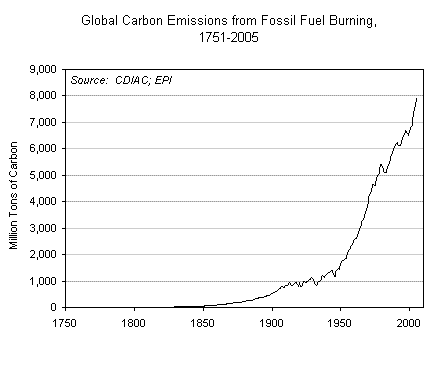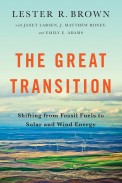"Lester Brown has produced another 'planetary survey' book that tells us how to get off the wrecking train we are on by courtesy of a dozen environmental assaults such as climate change. The better news (and there’s plenty) is that turning problems into opportunities generally puts money into our pockets." —Norman Myers, 21st Century School, University of Oxford on World on the Edge: How to Prevent Environmental and Economic Collapse
Click here to view the most recent Carbon Emissions Indicator and Data
In 2005, carbon emissions from the burning of fossil fuels climbed to a record high of 7.9 billion tons, an increase of some 3 percent from the previous year. Annual global emissions have been increasing since the beginning of the Industrial Revolution in the late eighteenth century, when humans first began burning fossil fuels on a large scale to produce energy. Since the early 1900s, emissions have been rising at an increasingly rapid pace. Annual emissions have grown by a factor of fifteen since 1900, advancing nearly 3 percent a year over that time. (See data.)

Half of all energy-related carbon emissions come from only four countries. The United States, with less than 5 percent of the world’s population, accounts for 21 percent of carbon emissions. It is followed by China, which emits 18 percent. Both countries are heavy users of coal, the most carbon-intensive fossil fuel. Russia accounts for 6 percent of carbon emissions, just ahead of Japan, which produces 5 percent of the global total. Other major contributors to global carbon emissions are India, Germany, Canada, the United Kingdom, South Korea, and Italy.
Qatar, with 14 tons of carbon emitted per person, leads the world in per capita emissions. This is due in part to its booming natural gas industry and the distribution of free electricity to households. Per capita emissions in Singapore and the United Arab Emirates stand at 9 tons per person, followed by Kuwait at 7 tons. These countries have very small populations and thriving economies that contribute to high per capita emissions. The United States, Australia, and Canada each emit roughly 5 tons of carbon per person each year. This is five times the figure in China and 17 times that in India.
Some 40 percent of energy-related emissions come from the burning of fossil fuels, such as oil, coal, and natural gas, to generate electrical power. The transportation sector is the second-largest source worldwide, responsible for 20 percent of all carbon emitted. Residential and commercial buildings account for roughly 15 percent of the total, and the industrial sector, another 15 percent. The remaining 10 percent of energy-related emissions come from a variety of minor uses, including fuels burned by sea-going ships.
As global emissions of carbon increase, they raise the levels of carbon dioxide (CO2) in the atmosphere. The average atmospheric concentration of CO2 reached 380 parts per million by volume in 2005, up 2.2 parts per million from 2004 levels and up 103 parts per million from pre-industrial times. The Intergovernmental Panel on Climate Change (IPCC), a global body of some 2,000 scientists, estimates that the current atmospheric CO2 concentration has not been exceeded over the last 420,000 years and probably not during the past 20 million years.
There is a scientific consensus that the increasing concentration of CO2 and other greenhouse gases in the atmosphere has caused global temperatures to rise. Over the past 30 years, global temperatures increased by 0.6 degrees Celsius (1.08 degrees Fahrenheit). The IPCC projects that this warming trend will continue and that global temperatures will rise by 1.4 to 5.8 degrees Celsius by 2100.
There are already numerous documented effects of global warming. The World Health Organization attributes 150,000 deaths each year to the effects of climate change. Sea level has risen by roughly 15 centimeters (6 inches) over the past century, while hurricanes have become more severe in the Atlantic and North Pacific. The combination of rising seas and stronger storms threatens the hundreds of millions of people who live in low-lying areas with increased likelihood of flooding and wind damage.
Experts predict that the effects of global warming will be far more dramatic if carbon emissions force atmospheric CO2 levels above 550 parts per million. Beyond this threshold, widespread flooding, droughts, and storms will be more severe. If carbon emissions continue to increase as projected, this level is likely to be reached in the second half of this century. To prevent this from happening, scientists estimate that carbon emissions must be cut by some 70 percent.
Much of the growth in carbon emissions over the next 25 years will come from developing countries. The world’s most industrialized countries currently account for 55 percent of all emissions. But developing and transitional economies led by China, Russia, and India are projected to be responsible for some 60 percent of global carbon emissions in 2030. A combination of rapid economic growth and heavy reliance on coal will drive this trend.
Though such projections are bleak, there are a number of promising examples to guide future action to reduce carbon emissions. Over the past 15 years, Germany reduced emissions by 10 percent, while the United Kingdom cut its emissions by some 3 percent. At the same time, each country sustained moderate economic growth. These two countries achieved such reductions by reducing their reliance on coal, increasing taxes on fossil fuels, mandating energy efficiency targets, and funding renewable energy promotion. To help meet its Kyoto Protocol commitments, the European Union launched an Emissions Trading Scheme in January 2005. This program limits carbon emissions and allows companies that reduce their emissions to profit by selling emissions permits to other companies.
In the United States, there are plans to reduce carbon emissions at the state level. Seven northeastern states have committed to a Regional Greenhouse Gas Initiative that mandates a 10-percent emissions reduction from 2009 levels by 2019. California, the world’s ninth largest economy, recently announced that it will reduce carbon emissions to 1990 levels by 2020. This policy is expected to boost state income by $4 billion and create 83,000 new jobs.
We can help to avoid the dangerous effects of global warming by enacting strong and mandatory policies to shift to renewable sources of energy and improve energy efficiency. With wind turbines, solar cells, energy-efficient household appliances, mass transit, and gas-electric hybrid vehicles, we now have the tools required to shift to a low-carbon economy. Also, there are policies that have been proven to reduce carbon emissions effectively, such as carbon taxes. Since human activities are now responsible for unprecedented changes in the global climate system, we each have the responsibility to work to decrease carbon emissions. The question is, will we act soon enough?
Copyright © 2006 Earth Policy Institute



 Print:
Print:  Email
Email


